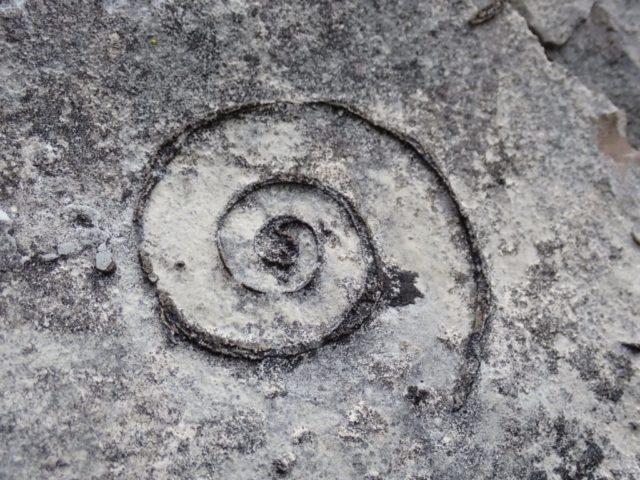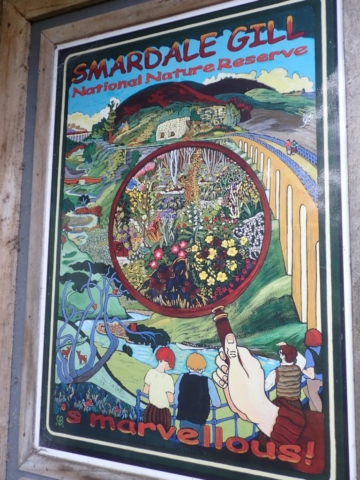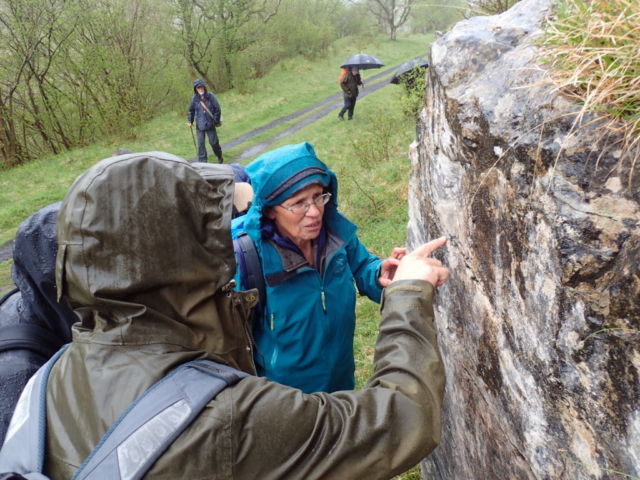Well, it was great to meet up again for real, rather than over a screen!
Even though the weather forecast deteriorated over the preceding days, sixteen of us met in the new car park at Smardale. We wished each other “Happy New Year’s” in the flesh.
Eventually 110 lichen species and 62 bryophyte species were recorded – good effort!
Lichens
Those interested in lichens remained in the car park- for quite a while. Some willows and ashes provided a variety of corticolous species, many of them lovers of nutrient enrichment: there was some well-developed Parmelina pastillifera with bun shaped isidia. The car park wall provided a variety of jelly lichens including Leptogium pulvinatum, Leptogium gelatinosum and Collema auriforme as well as limestone-loving crusts such as the pinky Acrocordia conoidea.
Eventually the group set off along the old railway line, Melanohalea laciniatula was quickly found on a trackside tree, and further along there was the pepperpot lichen, Pertusaria pertusa. Lecidella elaeochroma provided an opportunity to test whether everyone’s C, bleach, was still working. Non-lichen interest included water avens and St George’s mushroom.
The first railway viaduct provided an opportunity to look at a lot more limestone lichens, including Hymenilia prevosti ( it scratches green) and Caloplaca flavocitrina. Cladonia coniocraea was found growing at the foot of a wall. Some of us were more interested in the Peltigera species growing profusely on mossy log piles: P praetextata and membranacea were identified, but could that be P. rufescens? They are such variable things…and then a steam train came over the Settle-Carlisle line to distract us again.
Further progress along the track saw Thelotrema lepadinum being found, and a fine example of multi-tiered Cladonia chlorophaea: the cups bore cups which themselves bore cups. Traveling down into the valley through the woods was a tempting idea, but in the end we continued along the railway line.
Lunch was taken by a small viaduct over a beck: the sandstone construction gave us new lichens for the day: probable Lecidea lithophila, Porpidia tuberculosa (the K+UVpurple reaction was demonstrated) , Lecanora soralifera and Rhizocarpon reductum. Parmelia saxatilis was prolific on the railings.
A short distance further on and we were at the main viaduct. Swifts angled around us as Ochrolechia parella, Caloplaca crenularia, Pertusaria lactescens, Rhizocarpon geographicum, Melanelixia fuliginosa and Lecidea grisella and L. fuscoatra were found on the sandstone. Could that isidiate jelly lichen be Scytinium magnussonii? No, John Douglass’s later research revealed it was a young Collema fuscovirens.
The limestone cliffs just further on provided examples of squamulose lichens Romjularia lurida, Acarospora cervina, Toninia aromatica and T. sedifolia. We hoped that the limekilns might provide shelter from the rain and more interesting species, but were a bit of a disappointment. Time was moving on. The bryologists had called it a day, and as some of the party turned for home, we decided to as well. The woods would have to wait for another day.
So back to the car park it was. An extra-time short journey down the railway line towards Waitby provided some lovely thalli of Parmotrema perlatum, more Pertusaria pertusa and Anisomeridium polypori on the large trackside ash trees.
As so often, there’s lots of scope for a return visit in the future. Thanks to everyone for a grand day out, and Cumbria Wildlife Trust for permission to visit.
Pete Martin
Bryophytes
The bryo group spent some time in the car park, admiring the limestone wall which had a few interesting species, including Porella platyphylla and a nice example of Ditrichum gracile (which we now have to call Flexitrichum gracile), showing typical lax growth with stems a few centimetres long. We were all feeling a little rusty after several months without meetings, so it was good to have a look at some common species. Heading into the woodland, there was a patch of Anomodon viticulosus, frequent on limestone, while the trees had Zygodon rupestris, Ulota phyllantha, Orthotrichum stramineum and patches of a gemmiferous Metzgeria species. Peter Bullard checked it with his ultra-violet LED light and thought that the reaction, or lack of it, ruled out M. violacea, so this seems likely to be Metzgeria consanguinea.
We managed to continue at a reasonably brisk pace to reach the first viaduct which crossed the track. Walls under the viaduct had a good coverage of bryophytes, mainly limestone-loving species: Ctenidium molluscum, Neckera complanata, Schistidium crassipilum, Tortella tortuosa, Homalothecium sericeum. Taking the path down the slope after the viaduct, we headed into denser woodland on a very slippy muddy path. The ground was damp and shaded, with patches of Plagiochila porelloides and P. asplenioides. Peter Bullard was pleased to find Loeskeobryum brevirostre, an Atlantic woodland species, and Belinda Lloyd spotted some Radula complanata. We reached the beck at the bottom of the slope, and although there was only access to a limited stretch of the water we found a few interesting species, thanks to Kerry Milligan and Stuart Colgate who had come in wellies and waded into the stream to fetch samples of Fontinalis antipyretica, Cinclidotus fontinaloides and Platyhypnidium riparioides. There was also a good stretch of limestone wall with additional species Thamnobryum alopecurum, Didymodon insulanus, Scapania aspera, and Plagomnium rostratum creeping over stones at the base.
Most of us then returned to the main track, while Kerry and Stuart crossed the beck to check the opposite bank and slope, where they found Nowellia curvifolia, Riccardia palmata and Trichostomum brachydontium. A few of us continued across the viaduct and after a lunch break, headed to the quarry. This section of the track has more exposed limestone rock faces where there was Homalothecium lutescens. In the quarry itself we found a nice patch of Trichostomum crispulum and quite a bit of Syntrichia montana (previously S. intermedia). A few people had left by then and it was getting well into the afternoon when a heavy downpour sent the rest of us scurrying back to the car park. It was great to meet up with people ‘for real’ and get our brains back into bryophyte mode, as well as having the opportunity to exchange ideas and discuss IDs. We were particularly pleased to have such a good turnout and meet some new faces – thanks to everyone for coming!
Clare Shaw
























